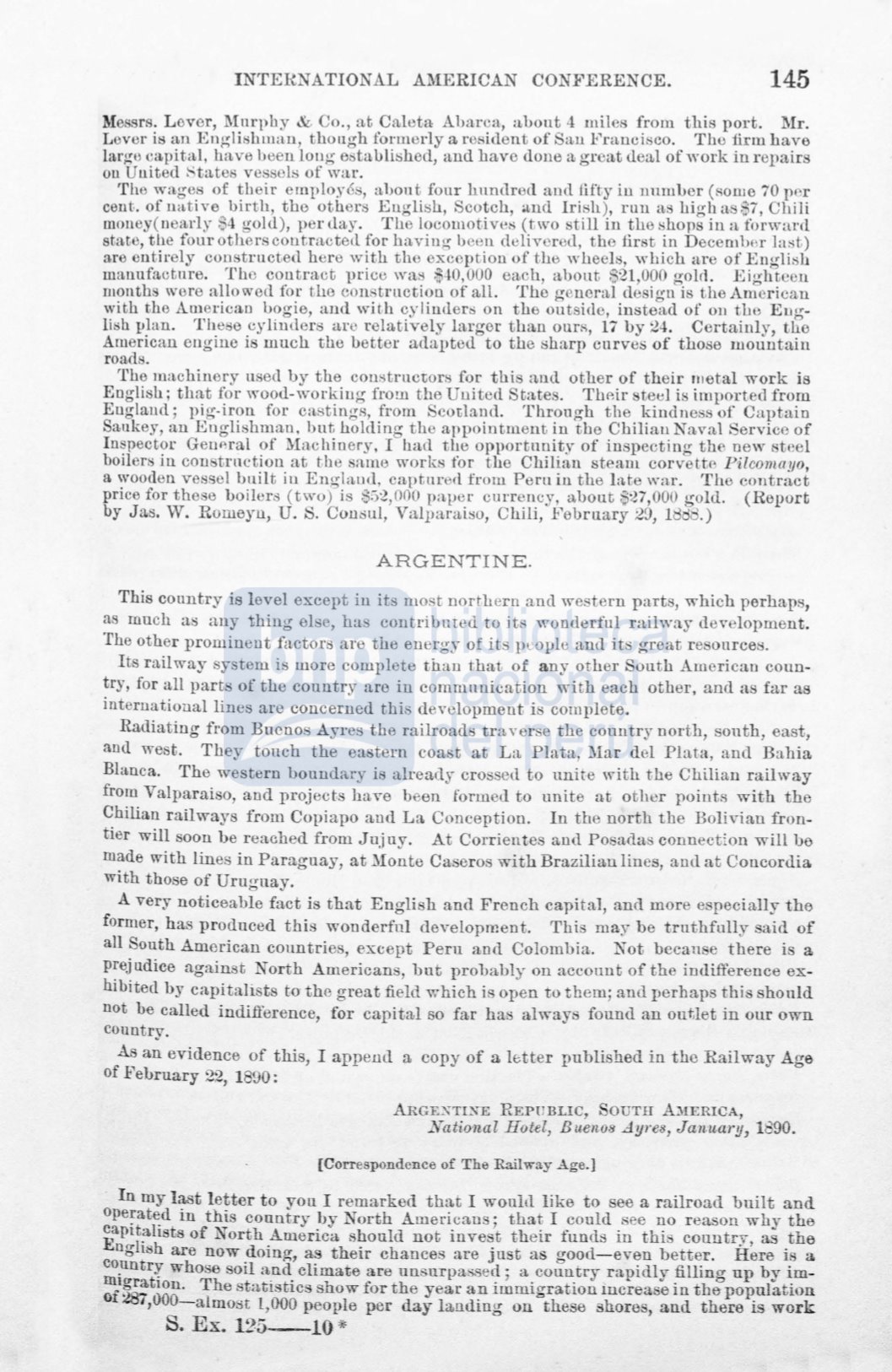
 INTEH.NATION.AL
INTEH.NATION.AL
AMERICAN CONFERENCE.
145
Messrs. Lcver, Murpby
&
Co., a.t Caleta Abarca, abont 4 miles from this port.
:Mr.
Lever is an
En~lishman,
thongh formerly a resident of San l<'rancisco. Tho :firm have
large capital, have Leen loug established, and have done a great deal of work in repairs
on Uuited :-\tates vesscls of war.
The wages of tlleir ernployés, ahont four hnndrecl and Jlfty iu nnmber (sorue 70 p<>r
cent. of native birth, the others Euglish, Scotch, and Irish), rnn as highas$7, Chili
money(nearly
$4
gold), per day. Tlw locomotivt's (two still in the shops in
a
forward
state, tlle four others coutmcteLl for havi ug been delivcred, tbe first in Decemher last)
are entirely constructed here with the exccption of the wheels, 'vbich are of English
manufacture. Thc contract price was :640,000 eacb, about . 21,000 golrt . Eightccn
months wcre allowecl for the con ·truction of all. The general design is the Ameri can
with the American bogie, and with cylinders on the outside, instead of ou the Eug–
lish plan. Tltese cyliuders are relatively larger t han our., 17 by
24.
Certainly, the
American engine is much the bettor aclaytcd to the sharp curves of those mountaiu
road.
The machinery used by the constructora for this aud other of their metal work is
English; tha.t for wood-working from the United Sta.tes. Thflir steel is imported from
Euglancl; pig-iron for castings, from Scor.bnd. Through the kindness of Captain
Saukey, an Englishman, but holding the appointment in tbe Chillan Naval Service of
Inspector GeuHral of Machinery, I had the opportnnit.v of inspecting the oew steel
boilen; in constrnction at the same works for t he Chilian steam corvettP
Pilcomayo,
a
wooclen vessel built
iu
En~laud,
captured from Peru in the late war. The contract
price for these boilers (two) is
:);)t,OOO
pa¡:Jer currency, about $27,000 gold.
(Report
by J as.
W.
Romeyn, U. S. Cou.sul, Valparaiso, Chili, J:i'ebruary
20,
1
d .)
ARGENTINE.
This country is level except in its most northern and western parts, which perhaps,
as
mnch as any tbing else, ha contributed to itR wonderful railway de\·elopment.
The other prominent factors are the energy of its pLople and its great re ources.
Its railway system is more complete than that of any other South American coun–
try, for
all
parts of the country are in commnnication with each other, anclas far
as
internationallines are concerned this de\'clopment is complete.
Radiating from Buenos Ayres tbe railroacls traverse the country north, sonth, east,
and west. Tbey touch the eastern coast at La Plata, :J.lar del Plata, and Babia
Blanca. The western boundary is
alrea.dycrosseü to unite with the Chilian railway
from Valparaiso, and projects have been formed to unite at other points with tbe
Chilian railways from Copiapo and La Conception.
In the nortb tbe Bolivian fron–
tier will soon be reacbed from Jujuy. At Corrientes antl Po ada connection will be
made with lines in Paraguay, at Monte Caseros with Brazilian lines, all(l at Concordia.
with those of Urn.-rnay.
A very noticeable fact is that Engli h an<l F rench capital, ancl more especially the
former, has produced this wonderfnl development. Thi ma)- be tmtbfully said of
all
South American countrie , except Peru aod Colombia. Not becanse tbere is a
prejudice agaiust North Americans, but probably on account of the indifference ex–
hibited by ca.pitalists to the great field whicb i open to tbem; and perhap thi shonld
not be called iudi1ference, for capital so far ha· always founcl an out.let in our own
couutry.
Asan evidence of thls,
I
appentl a copy of
a
}(,tter published in thc Railway Age
of .Fel.Jruary
22,
18()0 :
ARGE...."'>TI~E
REPllBLIC, SOUTH AIYIERICA,
National Hotel, Buenos Ay1·es, Jan¡¿ary,
1890.
{Correspondence of The Railway Age.]
In my Iast letter t o you I remarked that I woultl like to ee a railroad built and
ope~a.t~cl
in this country by North American·; that I could ;ee no reason why the
Eaptt~hsts
of Nortb America sbould not inve t their fnnds in this country, as tbe
nglt8h are now doing,
as tbeir chances are just as goorl- even better. Here
j
a
co.nntr;y whose soil and
clima.tea re unsurpasserl ; a country rapidly :filling up by im–
~l§~atwu.
The tati ti
cs showfor the year an irnmigr a.tion merca e iu the population
0
~7,000-almost
L,OOO
people pcr day la.nding on these shores, and there is work
S. Ex. 125--10 *
















